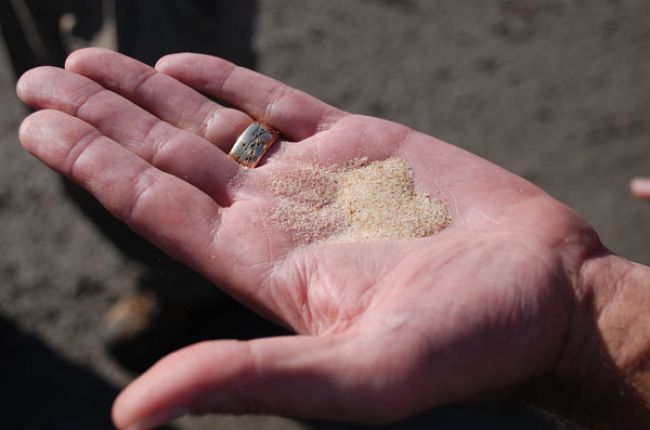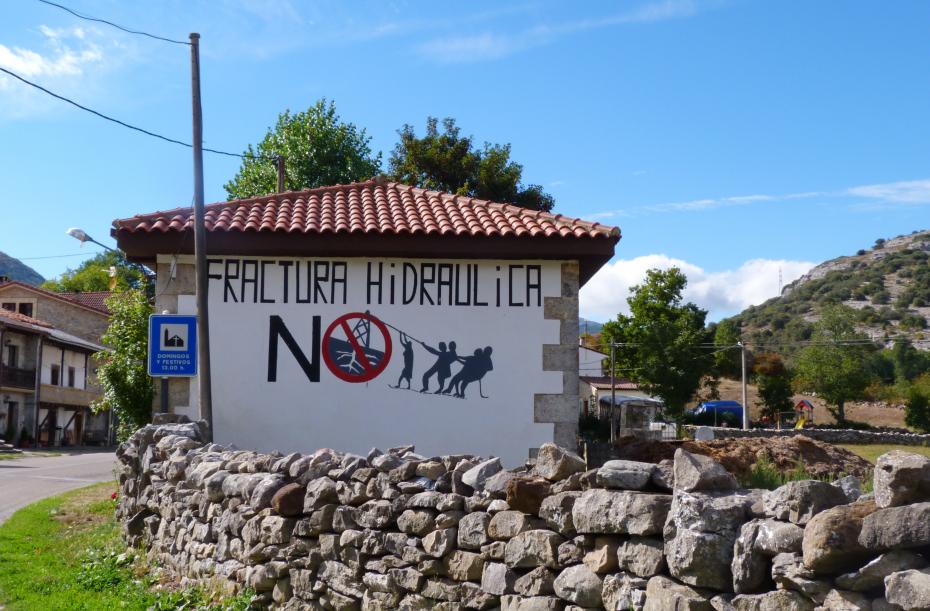What is frac sand?

Frac sand is a type of sand with small, uniform particles. It is injected into the rock formation along with the water used to fracture the rock in the process known as hydraulic fracturing ("fracking"). The sand is used to prop open the fractures that are created. Because the particles are uniform, fluids like water, oil, and gas are able to flow through the spaces between the particles. Frac sand is currently mined in a range of states, with the Great Lakes Region, consisting of Illinois, Minnesota, Michigan, and Wisconsin, contributing approximately 70% of the silica sand used in America as a proppant in 2014.
Learn More
Mining: Frac Sand (Webpage), Wisconsin Geological Survey
A short overview of frac sand, where it is found, and how it is mined, with links to other resources.
Frac Sand in the United States (Report), U.S. Geological Survey
A geological and industry overview of frac sand mining in the U.S.
DNR and Silica Sand (Webpage and Map), Minnesota Department of Natural Resources
Webpage on frac sand mining in Minnesota, with information on relevant legislation, answers to frequently asked questions about frac sand, and a map of sand mines in Minnesota.

Frac Sand Health and Environmental Impacts
Sand is critical to fracking. After workers drill down into rock, they create fractures by pumping in a mixture of water, chemicals and sand. The sand keeps the cracks propped open so that oil and gas are released.
Frac sand mining creates significant air pollution from the handling, mining, and processing of the sand. The important sources of air emissions come from the tiny dust particles – known as particulate matter – scattered during mining and processing.
These tiny dust particles, usually only a few microns in diameter, when inhaled in the lungs can lead to Silicosis – cancer of the lungs that poses a danger to miners and nearby communities.
Frac sand linked to lung disease in workers
The chronic silicosis caused by silica exposure poses unique dangers for employees working at frac sand mining sites. Because long-term exposure can be fatal, the Labor Department’s Occupational Safety and Health Administration (OSHA) issued draft regulations designed to reduce the health risk and previously issued a hazard alert.
Sand is basically silica — and breathing in silica is one of the oldest known workplace dangers. Inside the lungs, exposure to the tiny particles has been shown to sometimes lead to serious lung diseases like silicosis and lung cancer.
Workplace safety expert Eric Esswein and his team visited 11 fracking sites in five states: Arkansas, Colorado, North Dakota, Pennsylvania and Texas. At every site, the researchers found high levels of silica in the air. It turned out that 79 percent of the collected samples exceeded the recommended exposure limit set by the National Institute for Occupational Safety and Health.
There were some controls in place, says Esswein, who notes that “at every site that we went to, workers wore respirators.”
But about a third of the air samples they collected had such high levels of silica, that the type of respirators typically worn wouldn't offer enough protection.
Neighbors fear for their health
Wisconsinites and Minnesotans (the two states producing most of the frac sand) who live around frac sand mining, processing and transportation facilities are concerned about the long term impacts of their exposure to silica dust.
As a result, some local governments have enacted bans and moratoria.
Mining puts water at risk
Frac sand processing also poses dangers to water sources. Miners commonly use chemicals called flocculants to clean, wash, or remove unwanted minerals or other fine particles from the processed sand. These chemicals can infiltrate in to groundwater after washing.
Long term exposure to common flocculants like polyacrylamides and acrylamides in high concentrations of drinking water can lead to nervous system, blood problems or increased risk of cancer.
Neither the federal nor state governments have developed drinking water standards for flocculants.
For More Information
EARTHblog Frack sand mining doesn't just suck, it blows
EARTHblog In Frac Sand Land, Residents Have Little Protection Against Silica Dust Exposure
NPR Sand From Fracking Could Pose Lung Disease Risk To Workers
OSHA Worker Exposure to Silica during Hydraulic Fracturing
Price of Sand Film
CDC Silica
Civil Society Institute Communities At Risk: Frac Sand Mining in the Upper Midwest
What is Frac Sand?
Frac sand is a high-purity quartz sand with very round grains. It is very durable and provides a crush-resistant material used in the oil and gas industry for hydraulic fracturing (also called “fracking). Rock units composed of quartz grains that have gone through multiple cycles of weathering and erosion are potential sources of frac sand material. This evolution has removed most mineral grains other than quartz resulting in grains with very round shapes.
The demand for frac sand has risen dramatically in recent years as an increasing number of oil and natural gas wells use the hydraulic fracturing process. A single well using hydraulic fracturing can use a few thousand tons of frac sand. The surge of specialized drilling has created a billion dollar frac sand industry in just a few years.
How Frac Sand is Used
Some subsurface rock contains large amounts of oil, natural gas, or natural gas liquids that cannot flow freely to a well because the rock is impermeable to the degree that the fluids cannot flow through them. The fracking process presents a solution by creating fractures in the rock.
This is accomplished by drilling a well into the rock and sealing the portion of the well in the petroleum-bearing zone. Water treated with chemicals and thickeners to create a viscous gel is then pumped into that portion of the well using a high pressure process. The gel facilitates the water’s ability to carry grains of frac sand in a suspended state.
Large pumps at the surface increase water pressure in the sealed portion of the well until pressure is sufficient to fracture surrounding rocks. Water rushes rapidly through the fractures, making them larger and pushing them deeper into the rock. Because billions of sand grains are pushed deep into the fractures, it can take several thousand tons of frac sand to stimulate a single well.
Why Frac Sand Makes a Good Proppant
After the surface pumps are turned off, the fractures contract but do not close completely because they are propped open by billions of grains of frac sand. This occurs when there is sufficient sand remaining in the rock to resist the force of the closing fractures.
Frac sand is known as a “proppant” because it props the fractures open by forming a network of pore spaces that allow petroleum fluids to flow out of the rock and into the well. Although there are other types of proppants available, depending on the type of well, frac sand often delivers the highest performance.
Characteristics of High Quality Frac Sand
Proppants used in the petroleum industry must meet very demanding specifications. The typical characteristics of high quality frac sand include:
high-purity silica sand
a grain size that is perfectly matched to job requirements
a round shape that allows it to be carried in hydraulic fracturing fluid with little turbulence
durability to resist the crushing forces of closing fractures
Frac sand comes in various sizes. It can be as small as 0.1 millimeter in diameter to over 2 millimeters in diameter. Most frac sand used in the oil and gas industry is between 0.4 and 0.8 millimeters in size.

Understand the frac sand mining process - YouTube
- Uploaded by WKBT TV Frac sand mining is the mining of sand that is used in the fracking process to get oil and natural gas out of the
No comments:
Post a Comment